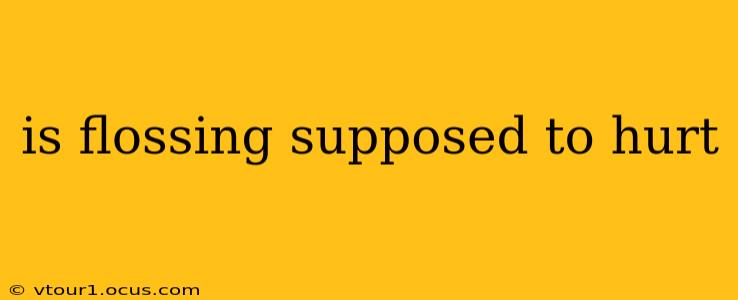Is Flossing Supposed to Hurt? Understanding the Sensitivity of Oral Hygiene
Flossing is a crucial part of maintaining good oral hygiene, but the question many people ask is: is flossing supposed to hurt? The short answer is no, flossing shouldn't cause pain. While you might experience some initial discomfort, particularly if you're new to flossing or haven't flossed regularly, persistent pain is a sign that something is wrong.
Let's delve into this further and address some common concerns:
Why Does Flossing Sometimes Hurt?
Several factors can contribute to discomfort while flossing:
-
Improper Technique: The most common reason for flossing pain is using the wrong technique. Forcing the floss too aggressively between teeth can injure your gums. Gentle, careful movements are key. We'll cover proper flossing techniques below.
-
Gingivitis: If your gums are already inflamed (gingivitis), flossing might be slightly painful. This is because the gums are sensitive and bleeding is more likely. Gingivitis is a sign of poor oral hygiene and requires addressing with better brushing and flossing techniques, possibly alongside professional dental cleaning.
-
Existing Gum Disease (Periodontitis): More severe gum disease (periodontitis) can make flossing more uncomfortable. Infected gums are often very sensitive, and flossing may even cause bleeding. If you experience significant pain and bleeding, consult your dentist.
-
Sensitive Teeth: Some individuals naturally have sensitive teeth, making flossing uncomfortable. This is often due to exposed dentin, the layer beneath the enamel. Using a gentler floss or a therapeutic toothpaste for sensitive teeth might help.
-
New Floss: Switching to a new type of floss can also cause temporary discomfort. Experiment with different types (waxed, unwaxed, flavored) to find one that works best for your mouth.
What is the Correct Flossing Technique?
Using the correct technique is crucial to avoid pain and maximize the benefits of flossing. Here's a step-by-step guide:
-
Take about 18 inches of floss. Wrap most of it around your middle fingers, leaving about an inch to work with.
-
Gently guide the floss between your teeth. Use a gentle sawing motion to avoid snapping the floss against the gums. Never force the floss.
-
Curve the floss into a "C" shape against one tooth. Gently slide it up and down the side of the tooth, reaching below the gum line.
-
Repeat on the adjacent tooth.
-
Use a clean section of floss for each tooth.
How Often Should I Floss?
The American Dental Association recommends flossing at least once a day, ideally before brushing your teeth at night. This helps remove food particles and plaque that your toothbrush might miss.
When Should I See a Dentist About Flossing Pain?
If you experience persistent pain, bleeding, or swelling while flossing, even after adjusting your technique, it's crucial to consult your dentist. These symptoms could indicate an underlying dental issue that requires professional attention.
Is there an alternative to flossing?
While flossing remains the gold standard for cleaning between teeth, some alternative tools exist, such as interdental brushes (for wider spaces between teeth) and water flossers. These can be helpful additions or alternatives for individuals who find traditional flossing difficult, but they should not replace flossing entirely. It's always best to discuss these options with your dentist.
In conclusion, while some slight discomfort is possible when you start flossing or have gum problems, persistent pain is not normal. Mastering the proper flossing technique, using a suitable floss type, and seeking professional advice when necessary are crucial for maintaining healthy gums and a pain-free flossing experience. Remember, regular flossing is vital for preventing cavities and gum disease – it's an investment in your long-term oral health.
